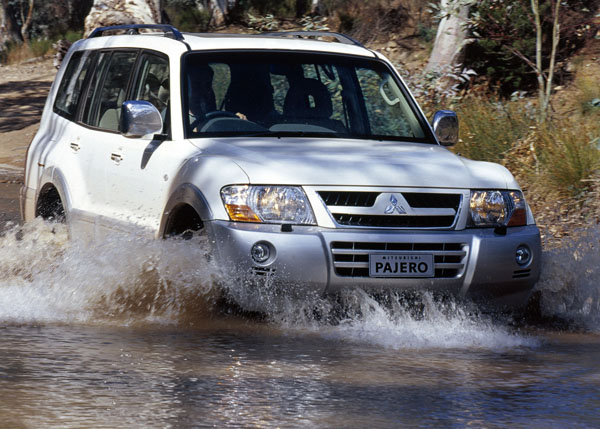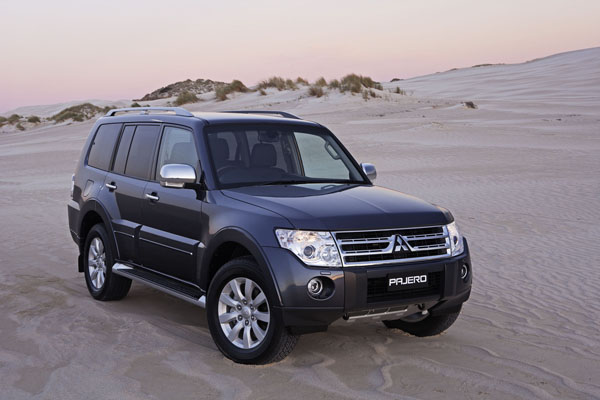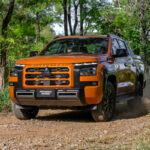Mitsubishi Pajero is often seen as being a tough looking people mover rather than a real 4WD, which is a pity because it’s pretty competent off-road and can handle most situations likely to be encountered by an adventurous holiday in the bush.
Mitsubishi Pajero comes as a station wagon with either two or four passenger doors. The two-door was never particularly popular and imports stopped with the all-new model of 2000, only to make a brief re-appearance when the new model was launched at the start of 2007, then pulled again in 2010.
The early two-door Mitsubishi Pajeros are shorter, lighter and more nimble than the four-doors. They provide plenty of fun at the beach and in tight off-road work. However, they are noticeably less roomy in the back seat and boot. The later ones are better for space, but have the usual problem of difficult access to the back seats because of high-ground-clearance. Kids are happy back there, but grandparents may not be all that keen.
All short-wheelbase Pajeros have five seats, the long-wheelbase models have either five or seven. The rearmost two seats in the seven-seat models are better suited to kids than adults but with a bit of squeezing up the Pajero can handle seven grown-ups.
The Pajero had body-on-chassis until 2000, although it was relatively refined for its type. Realising that most people demanded more comfort it was then given a monocoque (one-piece) body, something it has had ever since. Good engineering meant the post-2000 models retained similar strength to the chassis models.
The excellent Mitsubishi Super Select 4WD setup permits the use of 4WD under any circumstance. For example, safe traction on wet sealed roads if you opt for 4WD, or lower fuel consumption on dry dirt roads if you go for 2WD. Or anything in between. 4WD can be engaged or disengaged on the fly at any speed up to 100 km/h.
A 2.6-litre four-cylinder petrol engine was once common in the Pajero. It was discontinued in 1993 and most are now likely to be close to their use-by date. An honest enough performer, the four-cylinder was soon overshadowed by the V6s. The older V6s are 3.0-litre units, a 3.5 twin-cam unit was introduced in the topline Pajero Exceed in November 1993 and later moved down to the rest of the petrol Pajero range. A 3.8-litre V6 was introduced in September 2003.
Diesel power is relatively common in the early Pajeros, but fell from favour for a while before bouncing back in the early 2000s. The 2.8-litre four-cylinder turbo-diesel has plenty of torque and is reasonably economical. The 3.2-litre four-cylinder intercooled turbo-diesel from 2002 on is one of our favourite powerplants.
Five-speed manuals are offered in all but the topline Pajero Exceed. It wasn’t until 1995 that a manual was sold with the 3.5-litre V6. A four-speed automatic transmission works well enough, but the new five-speed auto introduced in 2000 is significantly better. As well as having the added ratio they run a sophisticated sequential system to give you a good degree of manual control.
The Australian Mitsubishi dealer network is long established and well-organised. Spare parts are generally available for all but the oldest models. Prices can be relatively high as 4WD bits are more rugged and can come as a surprise if you’ve only owned sedans in the past.
Insurance premiums are moderate for this class and there doesn’t seem to be much difference of opinion on the insurance risk amongst the major players.
HOW MUCH?
Expect to spend from $2000 to $4000 for a 1995 Mitsubishi Pajero GLX; $3500 to $6000 for a 2000 Exceed; $8000 to $12,000 for a 2005 GLX; $12,000 to $18,000 for a 2005 Exceed; $19,000 to $27,000 for a 2009 VR-X; $24,000 to $33,000 for a 2011 GLS; $34,000 o $46,000 for a 2013 VR-X; and $42,000 to $56,000 for a 2014 Exceed.
CAR BUYING TIP
Not many 4WDs ever go off sealed surfaces, Mitsubishi Pajero is one of the exceptions so be sure of the condition of a beach or bush basher before handing over your hard earned.














